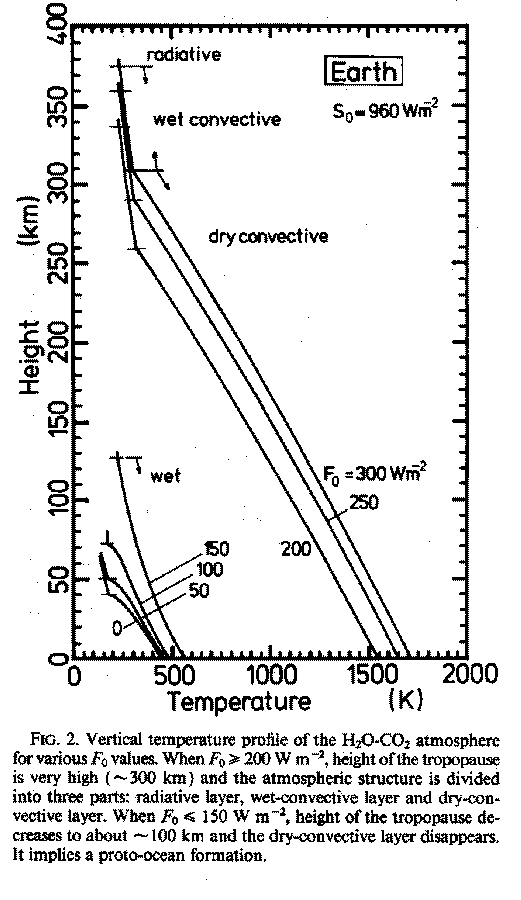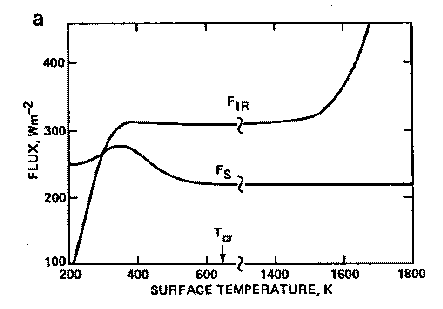A. Chronology of Studies on the Runaway Greenhouse State |
Chronology of Studies on the Runaway Greenhouse State
- Simpson(1927)
- Plass(1961)
- Gold(1964)
- Komabayashi (1967)
- Ingersoll (1969)
- Rasool and deBergh (1970)
- Pollack (1971)
- Lindzen et al. (1982)
- Vardavas and Carver (1985)
- Abe and Matsui (1988)
- Kasting (1988)
- Nakajima et al. (1992)
- Renno et al. (1995)
- Pierrerhumbert (1995)
Simpson(1927)
- Objective:
- To study climate stability
- Brief summary:
- Qualitative discussions based on the profile of the saturated water vapor pressure curve
- Results:
- This study suggests the presence of an upper limit of radiation that can be emitted from the atmosphere.
[Go back to Previous Studies on the Runaway Greenhouse State (Main Text)]
[Chronology] [Index]
Plass(1961)
- Objective:
- To examine the evolutions of the atmospheres of Venus and Earth
- Brief summary:
- A study on the temperature-evaporation feedback
- Results:
- This study pointed out the presence of a positive feedback between increasing evaporation and increasing air temperature.
[Go back to Previous Studies on the Runaway Greenhouse State (Main Text)]
[Chronology] [Index]
Gold(1964)
- Objective:
- To examine the evolutions of the atmospheres of Venus and Earth
- Brief summary:
- A study on the temperature-evaporation feedback
- Results:
- This study suggests the presence of a positive feedback mechanism between increasing evaporation and increasing air temperature, and also the possibility that a thermally runaway state can occur.
[Go back to Previous Studies on the Runaway Greenhouse State (Main Text)]
[Chronology] [Index]
Komabayashi (1967)
- Objective:
- To investigate climate stability
- Model:
- A gray stratospheric model
- Results:
- This study quantitatively shows that an upper limit exists on radiation that can be emitted from the stratosphere whose lower boundary is saturated with water vapor. For the details of the discussion in this study, refer to Characteristics of Radiative Equilibrium Solutions: Results of Stratospheric Model.
[Go back to Previous Studies on the Runaway Greenhouse State (Main Text)]
[Chronology] [Index]
Ingersoll (1969)
- Objective:
- Evolution of the atmosphere of Venus.
Because the atmosphere of Venus was in the runaway greenhouse state in the past, at which time water vapor was present in the atmosphere, it can be speculated that water vapor later underwent photodissociation in the upper atmospheric layers and hydrogen escaped, resulting in the current atmosphere of Venus.- Model:
- A gray stratospheric model
- Results:
- The analysis quantitatively reveals that there exists an upper limit on the amount of radiation that can be emitted by the stratosphere whose lower boundary is saturated with water vapor. The condition with the solar incident flux exceeding the upper limit value is referred to as the runaway greenhouse state. The study also suggests a possible occurrence of the runaway greenhouse state on Venus in the past. For the details of the discussion in Ingersoll (1969), refer to Characteristics of Radiative Equilibrium Solutions: Results of Stratospheric Model.
[Go back to Previous Studies on the Runaway Greenhouse State (Main Text)]
[Chronology] [Index]
Rasool and deBergh (1970)
- Objective:
- To study the evolution of the atmosphere of Venus
- Model:
- A 1D radiative-convective equilibrium model
- Results:
- This paper argues that a runaway greenhouse state occurred on Venus in the past.
[Go back to Previous Studies on the Runaway Greenhouse State (Main Text)]
[Chronology] [Index]
Pollack (1971)
- Objective:
- To investigate the evolution of the atmosphere of Venus
- Model:
- A 1D radiative-convective equilibrium model, non-gray atmosphere
- Results:
- This study shows that equilibrium cannot be achieved in the atmosphere-ocean system on present Venus and that the atmosphere of present Venus is in a runaway greenhouse state.
[Go back to Previous Studies on the Runaway Greenhouse State (Main Text)]
[Chronology] [Index]
Lindzen et al. (1982)
- Objective:
- To examine the effects of cumulus convection
- Model:
- A 1D radiative-convective equilibrium model. However, it has been pointed out that the model used by Lindzen et al. (1982) is subject to a number of shortcomings. For example, the amount of radiation calculated from the radiation scheme sometimes becomes larger than that based on black body emission.
- Results:
- It is concluded that a runaway greenhouse state does not occur in response to the effects of cumulous convection..
[Go back to Previous Studies on the Runaway Greenhouse State (Main Text)]
[Chronology] [Index]
Vardavas and Carver (1985)
- Objective:
- To examine the effects of cumulous convection
- Model:
- A 1D radiative-convective equilibrium model
- Results:
- This study examines to what degree the choice of the cumulous parameterization scheme, or the value of relative humidity cause differences in the values of incident solar energy flux that lead to the emergence of a runaway greenhouse state.
[Go back to Previous Studies on the Runaway Greenhouse State (Main Text)]
[Chronology] [Index]
Abe and Matsui (1988)
- Objective:
- During the formation stage of a terrestrial planet, a proto-atmosphere is present subsequent to degassing of volatile constituents, such as water vapor, as a result of violent planetesimal impacts (e.g., Abe and Matsui, 1985). Abe and Matsui (1988) investigates the structure of the proto-atmosphere in order to examine the ocean formation process as well as the early-phase evolution of the terrestrial planet.
- Model:
- A 1D radiative-convective equilibrium model. Non-grayness and non-ideality of gases are also taken into consideration.
- Results:
- The analysis shows that no ocean can exist if the incident solar energy flux is larger than approximately 300 W/m2. Therefore, it can be speculated that oceans would not be present on protoplanets and that protoplanets would be covered by an atmosphere of a few hundred [atm] of pressure. During the final formation stage of a terrestrial planet, which is characterized by a reduced frequency of planetesimal impacts, the energy supply into the atmosphere also declines, leading to the formation of oceans.

Figure 1: Figure 2 from Abe and Matsui (1988). The figure shows that the atmospheric structure is subject to large changes according to the value of incident energy flux.
[Go back to Previous Studies on the Runaway Greenhouse State (Main Text)]
[Chronology] [Index]
Kasting (1988)
- Objective:
- To investigate the early-phase evolution of a terrestrial planet
- Model:
- 1D radiative-convective equilibrium model
- Results:
- The study concludes that the runaway greenhouse state occurs when the solar energy flux input to the atmosphere is 1.4 times the current value of solar constant for the Earth.

Figure 2: Figure 7a from Kasting (1988), illustrating the relationship between surface temperature and outgoing infrared radiation, FIR. Even if surface temperature increases to 1500 K, outgoing longwave radiation cannot exceed approximately 300 W/m2.
[Go back to Previous Studies on the Runaway Greenhouse State (Main Text)]
[Chronology] [Index]
Nakajima et al. (1992)
- Pbjective:
- To summarize the concept of the runaway greenhouse state
- Model:
- A 1D radiative-convective equilibrium model
- Results:
- The study revealed that the following constraints exist on the radiation emitted by the atmosphere.
- The outgoing atmospheric radiation cannot exceed the Komabayashi-Ingersoll limit (the upper limit of radiation emitted by the stratospheric model). The Komabayashi-Ingersoll limit that results from the usage of parameters for a terrestrial-type planet is 385 W/m2
- Outgoing atmospheric radiation at high temperatures is larger than the radiation emitted by an atmosphere consisting only of water vapor. The upper limit of radiation emitted by the water vapor atmosphere is determined by the upper limit of upward radiative flux at the tropopause. The upper limit of radiation emitted by the water vapor atmosphere that results from the usage of parameters for a terrestrial-type planet is 300 W/m2.
Furthermore, this study suggests that the maximum value of the upward radiation at the tropopause is determined by the temperature structure of the troposphere. Actually, the upper limit of radiation that can be emitted by an atmosphere is determined by a smaller value in two constraint: the Komabayashi-Ingersoll limit and the upper limit of the radiative flux emitted by the tropopause. When the values of the mass of dry air and the specific heat are set to the values close to those of the Earth, the maximum value of radiation that can be emitted by the atmosphere is 350 W/m2. Nakajima et al. (1992) also shows that the point at which an equilibrium solution ceases, as outlined in Abe and Matsui (1988) and Kasting (1988), corresponds to the limit of radiation that can be emitted by the atmosphere, which is determined by the tropospheric temperature structure.
[Go back to Previous Studies on the Runaway Greenhouse State (Main Text)]
[Chronology] [Index]
Renno et al. (1994)
- Objective:
- To investigate to what degree the conditions of the occurrence of the runaway greenhouse state change according to the choice of method for incorporating cumulus convection
- Model:
- A 1D time evolution model. Six kinds of cumulus parameterization schemes including a convection adjustment scheme are used.
- Results:
- If relative humidity is comparatively large, a thermal runaway state appears regardless of the choice of the cumulus parameterization scheme. Renno et al. (1994) refer to this thermal runaway as a runaway greenhouse state. However, no discussions are made on the relationship between the upper limit of the radiation emitted by the atmosphere and the incident radiation that causes the runaway greenhouse state in the 1D radiative-convective equilibrium model adopted in their study .
[Go back to Previous Studies on the Runaway Greenhouse State (Main Text)]
[Chronology] [Index]
Pierrerhumbert (1995)
- Objective:
- To study the equilibrium state of the atmosphere
- Model:
- A box model that includes domains both with and without the occurrence of a runaway greenhouse state
- Results:
- This study presented the idea that atmospheric equilibrium is achieved through the heat transport from the domains with the occurrence of a runaway greenhouse state to those without such occurrence.
[Go back to Previous Studies on the Runaway Greenhouse State (Main Text)]
[Chronology] [Index]